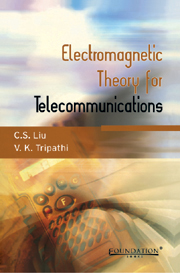Book contents
- Frontmatter
- Contents
- Preface
- 1 Electromagnetic Fields
- 2 Plane Waves
- 3 Guided Waves
- 4 Radiation
- 5 Radio Communication and Radar
- 6 Satellite Communication
- 7 Laser and Optical Fibre Communication
- 8 Geological Seisming and Remote Sensing
- 9 Relativistic Covariance of Electrodynamics
- 10 Radiation from Accelerated Charges
- Appendix A
- Appendix B
- Index
4 - Radiation
Published online by Cambridge University Press: 26 October 2011
- Frontmatter
- Contents
- Preface
- 1 Electromagnetic Fields
- 2 Plane Waves
- 3 Guided Waves
- 4 Radiation
- 5 Radio Communication and Radar
- 6 Satellite Communication
- 7 Laser and Optical Fibre Communication
- 8 Geological Seisming and Remote Sensing
- 9 Relativistic Covariance of Electrodynamics
- 10 Radiation from Accelerated Charges
- Appendix A
- Appendix B
- Index
Summary
Introduction
A current-carrying wire produces a magnetic field B in the region surrounding it (Fig. 4.1). If the current is periodic in time, it will produce a magnetic field-also periodic in time. According to Faraday's law of electromagnetic induction (∇ × E = -δB/δt), this magnetic field is accompanied by a time-varying electric field E. The Poynting vector due to these EandB fields turns out to be finite, pointing away from the wire. Thus a wire carrying periodic current is a source of electromagnetic radiation. If the wire were surrounded by a conducting cylinder carrying an equal and opposite current, eg., a coaxial cable, there would be no magnetic field outside the cylinder. Hence, only the exposed portion of the wire (not surrounded by a conducting cylinder) is the source of electromagnetic waves. This exposed portion of the wire is called an antenna.
The simplest antenna is a finite length straight wire with a cut in the middle. In fig. 4.2, wire AB is an antenna. It is cut in the middle and points C and D are connected to inner and outer conductors of a coaxial cable respectively, to feed current from a current source. Such a wire is known as centre-fed dipole antenna. The antenna acts as a resistive load for the transmission line (coaxial cable). When load impedance between C and D matches with the characteristic impedance of the line, there is no power reflection from the antenna into the line.
An important aspect of the fields produced by an antenna may be visualised intuitively.
- Type
- Chapter
- Information
- Electromagnetic Theory for Telecommunications , pp. 152 - 166Publisher: Foundation BooksPrint publication year: 2007



